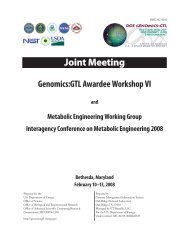Joint Meeting - Genomics - U.S. Department of Energy
Joint Meeting - Genomics - U.S. Department of Energy
Joint Meeting - Genomics - U.S. Department of Energy
You also want an ePaper? Increase the reach of your titles
YUMPU automatically turns print PDFs into web optimized ePapers that Google loves.
Milestone 1<br />
8<br />
Geobacter Project Subproject III: Functional Analysis <strong>of</strong> Genes <strong>of</strong><br />
Unknown Function<br />
Maddalena Coppi* (mcoppi@microbio.umass.edu), Carla Risso, Gemma Reguera, Ching Leang,<br />
Helen Vrionis, Richard Glaven, Muktak Aklujkar, Xinlei Qian, Tunde Mester, and Derek Lovley<br />
University <strong>of</strong> Massachusetts, Amherst, MA<br />
The development <strong>of</strong> models that can predict the physiological responses <strong>of</strong> Geobacteraceae under<br />
different environmental conditions in contaminated subsurface environments or on the surface <strong>of</strong><br />
energy-harvesting electrodes requires an understanding <strong>of</strong> the function <strong>of</strong> the genes expressed in<br />
these environments. However, no function has been assigned to a substantial number <strong>of</strong> genes in<br />
Geobacteraceae genomes and the actual physiological role <strong>of</strong> many genes annotated as having specific<br />
physiological functions has yet to be assessed.<br />
For example, it is important to understand acetate metabolism in Geobacter species, because acetate<br />
is the electron donor driving in situ uranium bioremediation and electricity production. Analysis<br />
<strong>of</strong> the Geobacter sulfurreducens genome revealed the presence <strong>of</strong> three homologs <strong>of</strong> the monocarboxylate<br />
transporter <strong>of</strong> E. coli, YjcG, which has recently been demonstrated to catalyze sodiumdependent<br />
acetate uptake. These homologs are 54-56% similar to E. coli YjcG and are ca. 90%<br />
similar to each other. G. sulfurreducens retained the ability to grow on acetate if the transporter genes<br />
were deleted singly, but a triple mutant could not be isolated. This result suggests that the three<br />
transporters are essential for growth on acetate, but that they may be functionally redundant. We are<br />
currently investigating the possibility <strong>of</strong> compensatory interactions between the three transporters<br />
in the mutant strains. The central metabolic pathways for acetate oxidation and incorporation into<br />
biomass have also been subjected to intensive genetic analysis. A model <strong>of</strong> acetate metabolism based<br />
on the results <strong>of</strong> these studies will be presented.<br />
Previous studies demonstrated that at subatmospheric oxygen tensions, G. sulfurreducens can grow<br />
utilizing oxygen as an electron acceptor, a physiological capability that may be important for survival<br />
<strong>of</strong> Geobacter species in subsurface environments. Two complexes potentially involved in oxygen<br />
respiration are encoded in the genome <strong>of</strong> genome <strong>of</strong> G. sulfurreducens, a cytochrome c oxidase and<br />
a cytochrome d oxidase. Both enzymes are present in most aerobic bacteria and have a low or high<br />
affinity for oxygen, respectively. A G. sulfurreducens mutant lacking the cytochrome c oxidase could<br />
not grow on oxygen, but retained the ability to consume oxygen, presumably via the cytochrome d<br />
oxidase. Further genetic analysis <strong>of</strong> this possibility is underway.<br />
The physiologic role <strong>of</strong> the SfrAB complex <strong>of</strong> G. sulfurreducens, which was previously designated<br />
a cytoplasmic Fe(III) reductase, was investigated in detail, because understanding the site <strong>of</strong> metal<br />
reduction is crucial for modeling the energetics <strong>of</strong> this process. A knockout mutant deficient in<br />
SfrAB could not grow with acetate as the electron donor with either fumarate or Fe(III) as the<br />
electron acceptor, but readily grew with hydrogen or formate as the electron donor, if acetate was<br />
provided as a carbon source. This phenotype suggested that the SfrAB-deficient mutant was specifically<br />
impaired in acetate oxidation via the TCA cycle. After several weeks, SfrAB deficient strains<br />
developed the ability to grow on fumarate with acetate serving as the electron donor. Membrane<br />
and soluble fractions prepared from these acetate-adapted strains, were depleted <strong>of</strong> NADPHdependent<br />
Fe(III), viologen, and quinone reductase activities relative to those <strong>of</strong> wild type. It was<br />
hypothesized that the lack <strong>of</strong> SfrAB inhibits growth on acetate by increasing the NADPH:NADP<br />
14 * Presenting author





